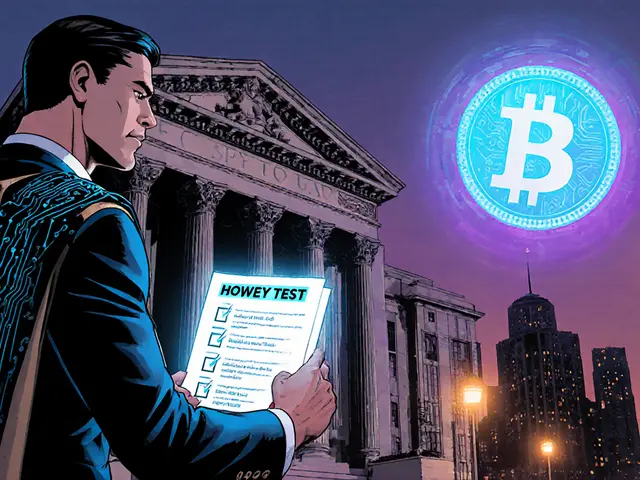- Home
- Cryptocurrency
- 2025 Guide to Crypto Securities Registration Requirements in the US

2025 Guide to Crypto Securities Registration Requirements in the US
Crypto Securities Registration Checker
Token Classification Assessment
Use this tool to determine if your token is a security and which registration form you should file based on the 2025 SEC guidance.
When you hear "Crypto securities is a digital asset that meets the legal definition of a security under U.S. law, the first question is usually: do I need to register it? The answer hinges on a mix of statutes, SEC guidance released in 2025, and a few key tests. This guide walks you through the most important steps, from deciding whether the Howey test applies to filing the right forms, and shows where recent reforms like the crypto securities registration landscape have shifted.
Quick Takeaways
- Determine if the token passes the Howey test - if yes, treat it as a security.
- File Form S‑1 for public offerings or Form D for Regulation D exemptions.
- Disclose risk factors, custodial arrangements, and fees in a prospectus summary.
- The SEC Crypto Task Force’s 2025 guidance clarifies that mining operations are generally exempt.
- The CLARITY Act separates commodity‑class tokens from security tokens, reducing reporting for the former.
Legal Foundations
The backbone of any registration effort is the Securities Act of 1933 is the primary federal law requiring registration of securities offers and the Securities Exchange Act of 1934 is the statute governing ongoing reporting for registered securities. Both acts were written long before blockchain, but the SEC has adapted them through guidance and enforcement.
In 2025, Acting Chair Mark T. Uyeda launched the SEC Crypto Task Force is a dedicated unit that drafts practical rules for digital assets. Its July 1, 2025 release on Crypto Asset Exchange‑Traded Products (ETPs) set a new baseline for disclosure language - clear, concise, and jargon‑free.
Step‑by‑Step: Is Your Token a Security?
- Apply the Howey test. The Howey test is a four‑part analysis that asks whether there is an investment of money, in a common enterprise, with an expectation of profit derived from the efforts of others. If all four elements are satisfied, the token is a security.
- Check for exemptions. Common exemptions include Regulation D (private placements), Regulation A+ (mini‑IPOs), and the newly‑codified CLARITY Act is legislation that reclassifies certain decentralized tokens as commodities, removing them from securities law.
- Identify the issuer’s business model. If the token represents equity, debt, or profit‑sharing rights, registration is almost always required.
- Review SEC staff statements. The March 20, 2025 memo clarified that pure mining operations do not trigger securities registration.
- Document the analysis. Keep a written Howey test assessment - regulators expect this in the registration filing.
Choosing the Right Registration Form
Once you’ve concluded the token is a security, the next decision is which filing to use. Below is a quick matrix of the most common forms.
| Form | Typical Use | Public vs. Private | Key Disclosure Elements |
|---|---|---|---|
| Form S‑1 | Initial public offering (IPO) of tokenized equity | Public | Prospectus summary, risk factors, business description, financial statements |
| Form S‑3 | Secondary offerings (follow‑on) after S‑1 qualification | Public | Same as S‑1 but streamlined |
| Form D | Regulation D private placement | Private | Accredited investor verification, offering amount, use of proceeds |
| Form 1‑A (Reg A+) | Mini‑IPO up to $75million | Public | Similar to S‑1 but reduced financial reporting |
| Form 8‑K | Material events after registration | Public | Changes in custody, fee structure, or major partnership |

Key Disclosure Requirements under the 2025 Guidance
The July 1, 2025 SEC guidance on Crypto Asset ETPs enumerates eight disclosure blocks that every registration filing should address. Below is a practical checklist.
- Prospectus Summary: One‑page snapshot of the token’s purpose, structure, and primary risks.
- Risk Factors: Include smart‑contract vulnerabilities, regulatory uncertainty, custodial risk, and market liquidity.
- Business Description: Explain the underlying blockchain, tokenomics, and how the token ties to the issuer’s operations.
- Service Providers & Custodians: Name the wallet providers, custodial agents, and any third‑party auditors.
- Fees & Expenses: Outline transaction fees, management fees, and any platform‑specific charges.
- Plan of Distribution: Detail how the token will be marketed, sold, and listed on exchanges.
- Management & Conflicts of Interest: Disclose insider holdings, token‑buy‑back programs, and any related‑party arrangements.
- Financial Statements: Provide audited statements for the issuer and, if applicable, for each subsidiary that issues the token.
Remember, the SEC wants language that a typical investor can understand. Avoid deep‑technical jargon unless it’s defined in a glossary.
Interaction with the CFTC and the CLARITY Act
The September 2, 2025 Joint Statement between the SEC and the CFTC clarified that national securities exchanges can list spot crypto assets, as long as they comply with existing rules. This cooperative stance means you’ll often have to satisfy both agencies.
If your token is re‑classified under the CLARITY Act is a bill that moves decentralized, non‑security tokens into the commodity domain overseen by the CFTC, you’ll face a different reporting regime: CFTC’s Form 40‑B reporting and, for advisors, a potential switch to Commodity Trading Adviser registration.
In practice, many firms adopt a “dual‑track” compliance model: treat tokenized equities as securities for SEC filing, while handling utility‑style tokens under CFTC guidance.
Practical Tips for Issuers and Advisers
- Start the Howey analysis early. The assessment is foundational; pull it into your business plan.
- Leverage the Crypto Task Force’s templates. The SEC has published sample prospectus language that reduces drafting time.
- Map your custodial solution. Whether you use self‑custody or a qualified custodian, disclose the security controls and insurance coverage.
- Plan for post‑issuance reporting. Registered securities must file annual Forms 10‑K, quarterly Forms 10‑Q, and current reports on material events (Form 8‑K).
- Educate your Access Persons. Under Rule 204A‑1, staff at Registered Investment Advisers must disclose holdings of reportable securities - many RIAs now treat all digital assets as reportable to stay safe.
Common Pitfalls to Avoid
Even with the new guidance, issuers still stumble on a few recurring mistakes:
- Misclassifying a token. Assuming a utility token is automatically a commodity can trigger enforcement actions.
- Under‑disclosing custodial risk. Investors want to know who holds the private keys and what insurance is in place.
- Using overly technical language. The SEC’s 2025 rulebook penalizes prospectuses that require a blockchain engineer to decode.
- Skipping the Howey memo. Regulators frequently request the internal analysis as part of the filing supplement.
- Neglecting the Joint Statement. Forgetting that a spot crypto product may be listed on a national exchange without a new rule can delay market entry.
Future Outlook
Looking ahead, the Crypto Task Force signals that more refined safe harbors for ICOs, airdrops, and network rewards will arrive by late 2025. Expect clearer templates for “purpose‑fit disclosures” that reduce the burden on smaller projects while preserving investor protection.
For compliance officers, the key is to stay agile - update internal policies whenever the SEC releases a staff statement, and keep an eye on CFTC rule proposals that could shift commodity‑class token treatment.

Frequently Asked Questions
Does the Howey test apply to every crypto token?
No. The Howey test is applied case‑by‑case. Tokens that merely provide access to a decentralized network without profit expectations usually fail the test and are treated as commodities.
What form should I file for a private sale of a security token?
Most issuers use Form D under Regulation D, provided they only sell to accredited investors and keep the offering under the $10million threshold.
Is a token issued to fund a mining pool a security?
According to the SEC’s March 20, 2025 staff statement, pure mining operations are exempt from securities registration, as long as investors do not receive profit‑sharing rights tied to the operator’s effort.
How does the CLARITY Act affect existing token offerings?
The Act re‑classifies certain decentralized tokens as commodities, removing them from SEC registration but adding CFTC reporting obligations. Existing security token offerings remain under SEC rules unless they are voluntarily re‑structured.
What new disclosure items did the 2025 SEC guidance add?
Beyond the classic prospectus sections, the guidance required clear articulation of custodial arrangements, token‑specific fees, and a concise risk‑factor narrative that mentions smart‑contract bugs and regulatory change risk.
Cormac Riverton
I'm a blockchain analyst and private investor specializing in cryptocurrencies and equity markets. I research tokenomics, on-chain data, and market microstructure, and advise startups on exchange listings. I also write practical explainers and strategy notes for retail traders and fund teams. My work blends quantitative analysis with clear storytelling to make complex systems understandable.
Popular Articles
19 Comments
Write a comment Cancel reply
About
DEX Maniac is your hub for blockchain knowledge, cryptocurrencies, and global markets. Explore guides on crypto coins, DeFi, and decentralized exchanges with clear, actionable insights. Compare crypto exchanges, track airdrop opportunities, and follow timely market analysis across crypto and stocks. Stay informed with curated news, tools, and insights for smarter decisions.





Wow, this guide really breaks down the new 2025 rules in a way that's easy to follow. I like how the Howey test steps are listed clearly. The checklist for disclosures is especially helpful for teams that are just getting started. It’s good to see the SEC finally giving some concrete templates. Hope this makes the filing process less scary for small projects.
Absolutely, Danny, you’ve hit the nail on the head, and I’d add that the real win here is the SEC’s push for plain‑language prospectuses, which means fewer legal gobbledygook, more investor clarity, and-let’s be honest-less back‑and‑forth with counsel, which is a huge time saver for startups, especially those juggling tokenomics and compliance at the same time.
Reading this so‑called “guide” feels like slogging through a bureaucratic swamp with a leaky raft. First, the author pretends the Howey test is some revolutionary checklist, when in reality it’s just the same old four‑point litmus that regulators have been using for decades. Second, the list of forms-S‑1, S‑3, Form D, Reg A+-reads like a menu for a fast‑food joint that promises gourmet meals but delivers bland paperwork. Third, the section on CLARITY Act is vague, suggesting it “reduces reporting” without explaining the new CFTC filing burdens, which are anything but reduced. Fourth, the advice to “leverage templates” ignores the fact that each template is riddled with boilerplate that can trigger red flags during review. Fifth, the guide fails to mention the cost-legal fees alone can run into six‑figures for a modest token launch. Sixth, the discussion of custodial disclosures is superficial, glossing over the critical issue of private‑key security and insurance coverage. Seventh, the risk‑factor checklist repeats the same buzzwords-“regulatory uncertainty,” “smart‑contract bugs”-without offering actionable mitigation strategies. Eighth, the claim that mining operations are exempt is overly simplistic; many mining contracts involve profit‑sharing that could still be deemed securities. Ninth, the author’s tone is overly optimistic, as if compliance is a light‑weight hurdle rather than a complex, evolving legal maze. Tenth, the roadmap to post‑issuance reporting is thin, ignoring the heavy lifting required for forms 10‑K, 10‑Q, and 8‑K. Eleventh, the guide’s examples are all U.S.‑centric, neglecting the growing relevance of international regulators who may impose their own demanding standards. Twelfth, the suggested “dual‑track” compliance model is presented as a seamless solution, yet coordinating SEC and CFTC filings often leads to contradictory disclosures. Thirteenth, the write‑up lacks any real case studies to illustrate successes or failures, making it feel like theory without practice. Fourteenth, the language occasionally drifts into legalese, defeating the author’s own advice for plain English. Fifteenth, overall this guide feels like a superficial PR piece rather than a substantive, actionable manual for serious token issuers.
This guide is a waste of time; the SEC’s rules are a nightmare you can’t dodge.
One must consider the broader implications of the 2025 SEC guidance, which appears to be part of an orchestrated effort by entrenched financial interests to consolidate power over emerging digital assets. The language of “clarity” and “safety” masks a strategic intent to marginalize decentralized innovations, thereby preserving the status quo of centralized capital markets. Moreover, the coordination between the SEC and the CFTC, as evidenced by the joint statement, suggests a tacit collusion that could undermine the sovereignty of blockchain protocols. Such developments warrant vigilant scrutiny, lest the regulatory apparatus become an instrument of covert economic control.
Oh great, another checklist-because what the crypto world really needed was more paperwork to fill out, right? I guess the next step is to ask the SEC to approve the colors of our token logos while they’re at it. Still, it’s kind of impressive how they managed to cram so many legal hoops into a single guide. Maybe the real innovation will be figuring out how to comply without losing our sanity.
Even though the compliance process looks dense, it’s actually a sign that the market is maturing, and that’s something to celebrate. Taking these steps now can build investor trust and set a solid foundation for future growth.
The document attempts to modularize the registration workflow, but the proliferation of form identifiers-S‑1, D, 1‑A-creates an unnecessary taxonomy that obfuscates the underlying capital formation mechanisms. A more streamlined schema would reduce cognitive load for token engineers.
The guide covers the basics adequately.
Hey folks, great post, really comprehensive,, I think the section on custodial disclosure could use a bit more detail,, like what kind of insurance policies are typical,, and also a quick note on multi‑sig wallets,, would be helpful,, sorry for the typos,, but hope this adds value.
In perusing the aforementioned exposition, one cannot help but discern a certain paucity of erudition, a lamentable omission of the nuanced dialectics that undergird tokenomics, ahh perhaps an oversight, but nonetheless a subtle invitation for deeper scholarly interrogation.
Esteemed practitioners, the salient takeaway from this comprehensive treatise is the imperative to integrate regulatory diligence at the inception of any token issuance. By adhering to the prescribed disclosure protocols, issuers not only mitigate legal risk but also engender confidence among discerning investors. Let us therefore embrace these guidelines as a catalyst for sustainable innovation within the digital asset ecosystem.
Reading through this guide feels a bit like being handed a beautifully bound instruction manual for a spaceship that’s secretly being built by a cabal of shadowy financiers who want to keep us grounded. The SEC’s “clarity” is nothing more than a euphemism for a grand design to rein in the wild frontier of blockchain, subtly guiding the narrative while pulling the strings behind the curtain. One can almost imagine the bureaucrats huddling in dimly lit rooms, drafting clauses that look innocuous but are laced with hidden tax traps and surveillance provisions. The mention of the CLARITY Act, for instance, could be interpreted as a smokescreen to reclassify tokens and funnel them into a regulatory labyrinth where the CFTC and SEC can monitor every transaction. Moreover, the guide’s earnest optimism about “dual‑track” compliance might actually be a strategic ploy to divide the community, creating factions that monitor each other while the true puppeteers remain in the shadows. Perhaps the most telling sign is the insistence on plain‑language prospectuses-sure, make it simple for the average investor, but also make it easier for the powers that be to parse and flag any deviation from the prescribed path. In this grand theater, the token issuers are the actors, the regulators are the directors, and the audience-us-are left to wonder whether the script is ours or theirs. So, while the guide is undeniably thorough, one must keep an eye on the subtle undercurrents that hint at a larger, perhaps more insidious, agenda at play.
In formal analysis, it becomes evident that the regulatory framework outlined herein endeavors to balance investor protection with market innovation; nevertheless, the intricate interplay between SEC mandates and CFTC oversight warrants meticulous scrutiny, lest unintended compliance gaps emerge. :)
The evolution of token regulation reflects a broader dialectic between technological emancipation and institutional order, inviting contemplation on how decentralized systems may coexist with established legal structures.
This guide is actually pretty useful.
Honestly, the whole thing feels like a scripted drama where the SEC is the playwright, the CFTC the stage manager, and we, the naïve creators, are forced to perform in a plot that was written long before we ever imagined a token could exist.
Great job on breaking down the complexities; this will definitely help many teams navigate the filing maze. Keep it up! 😊
The article offers a solid overview of the 2025 registration requirements, outlining both the Howey test and the relevant forms, while also highlighting key disclosure elements and common pitfalls, making it a valuable reference for issuers.